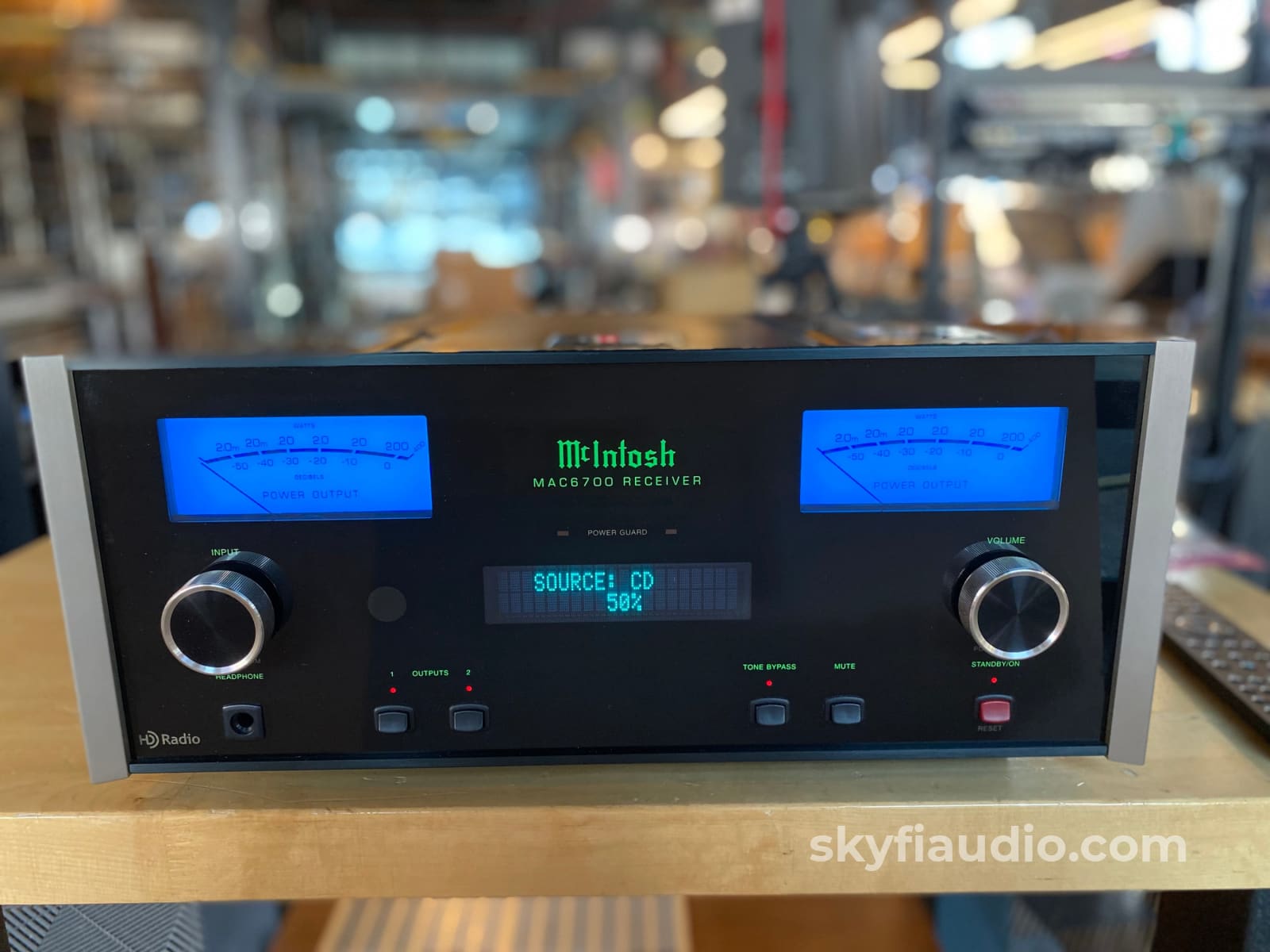
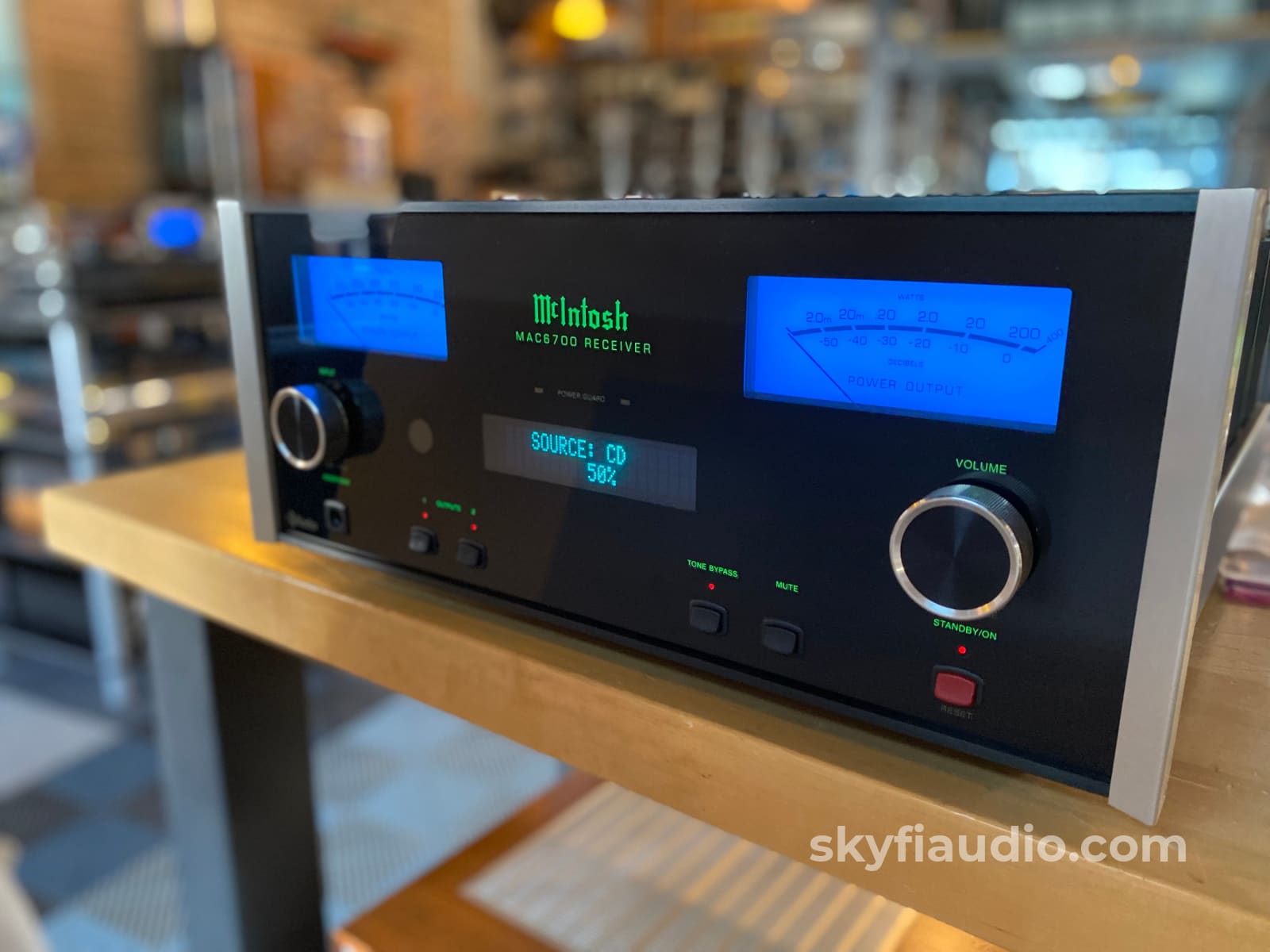
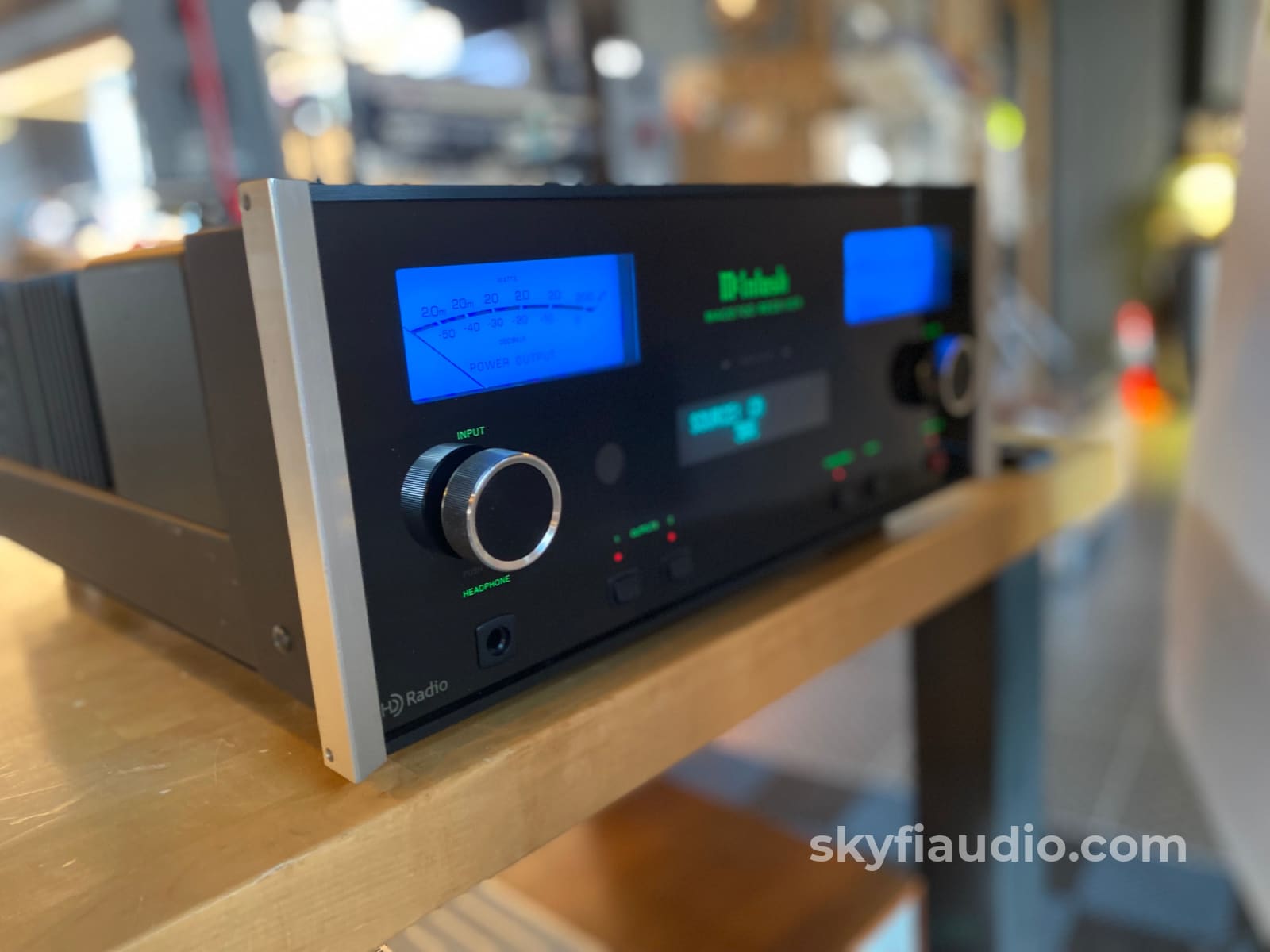
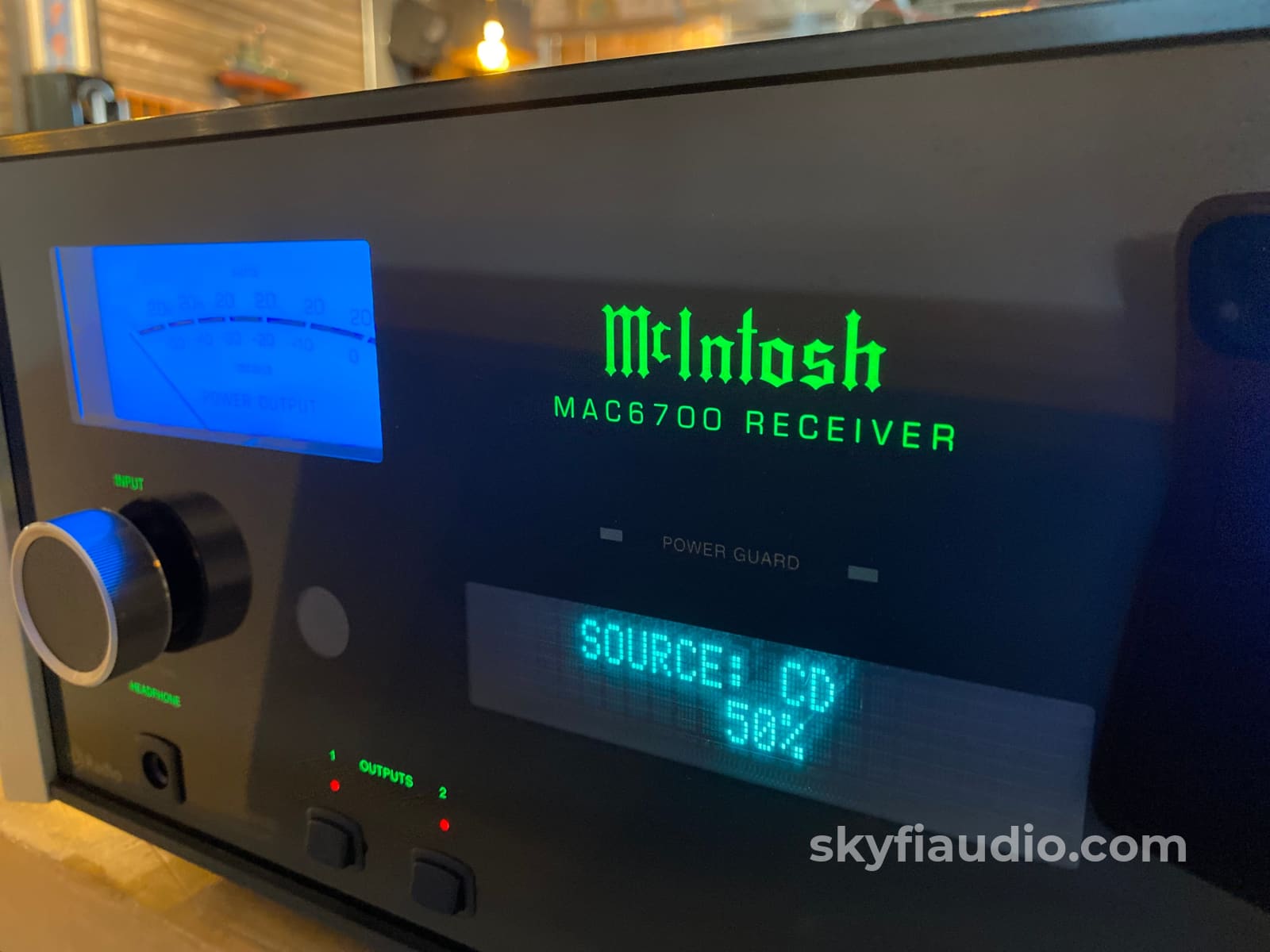
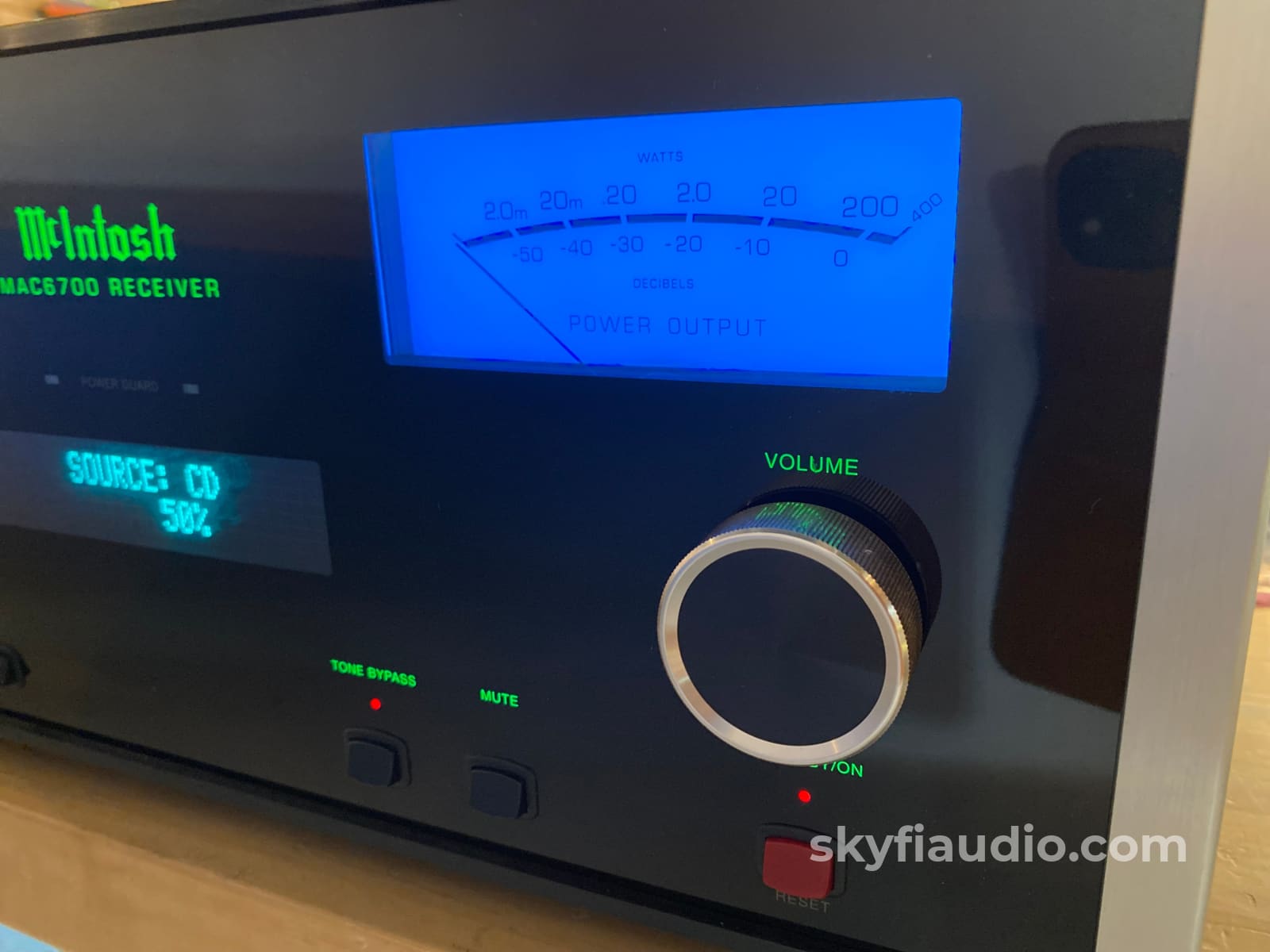
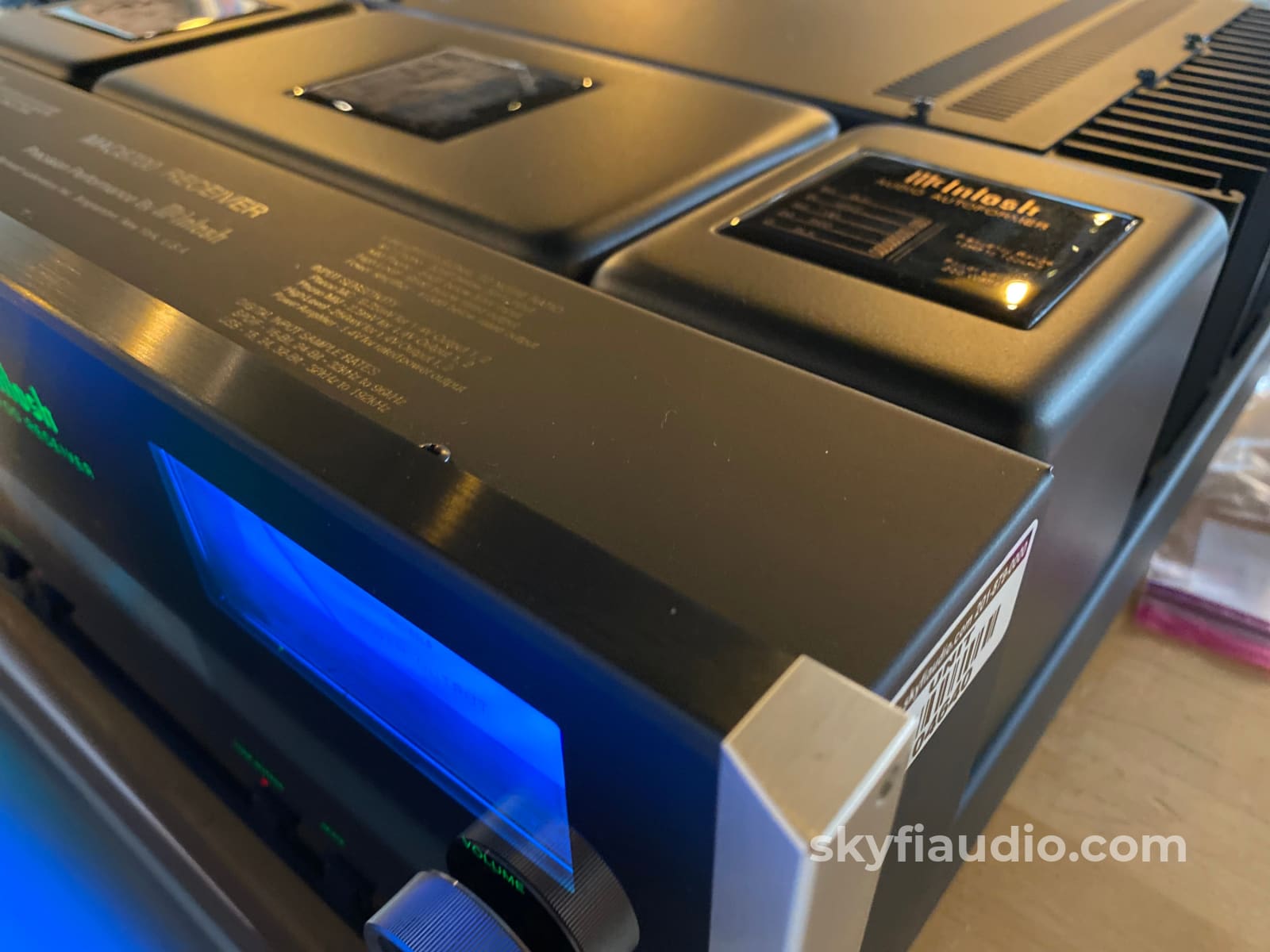
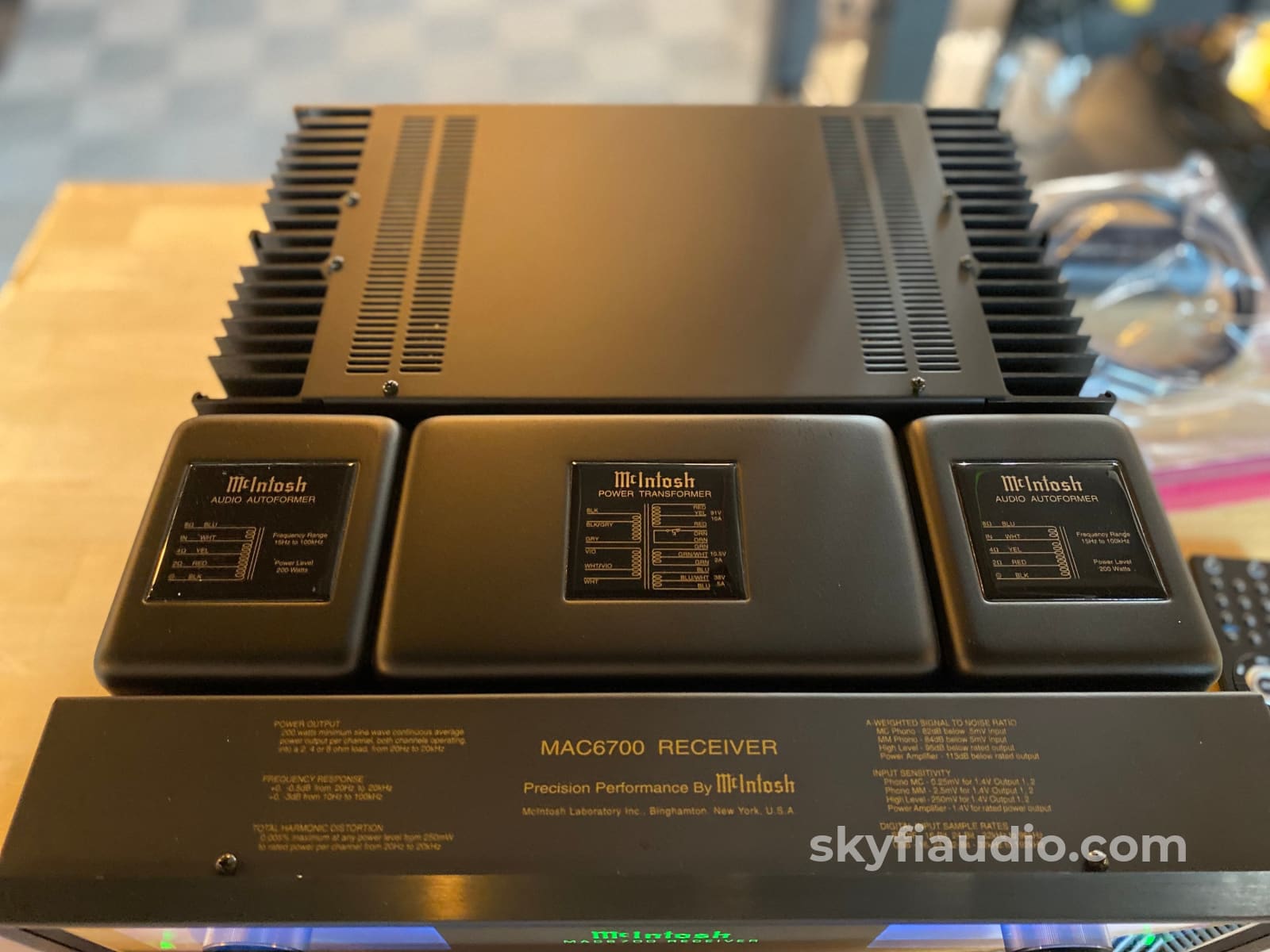
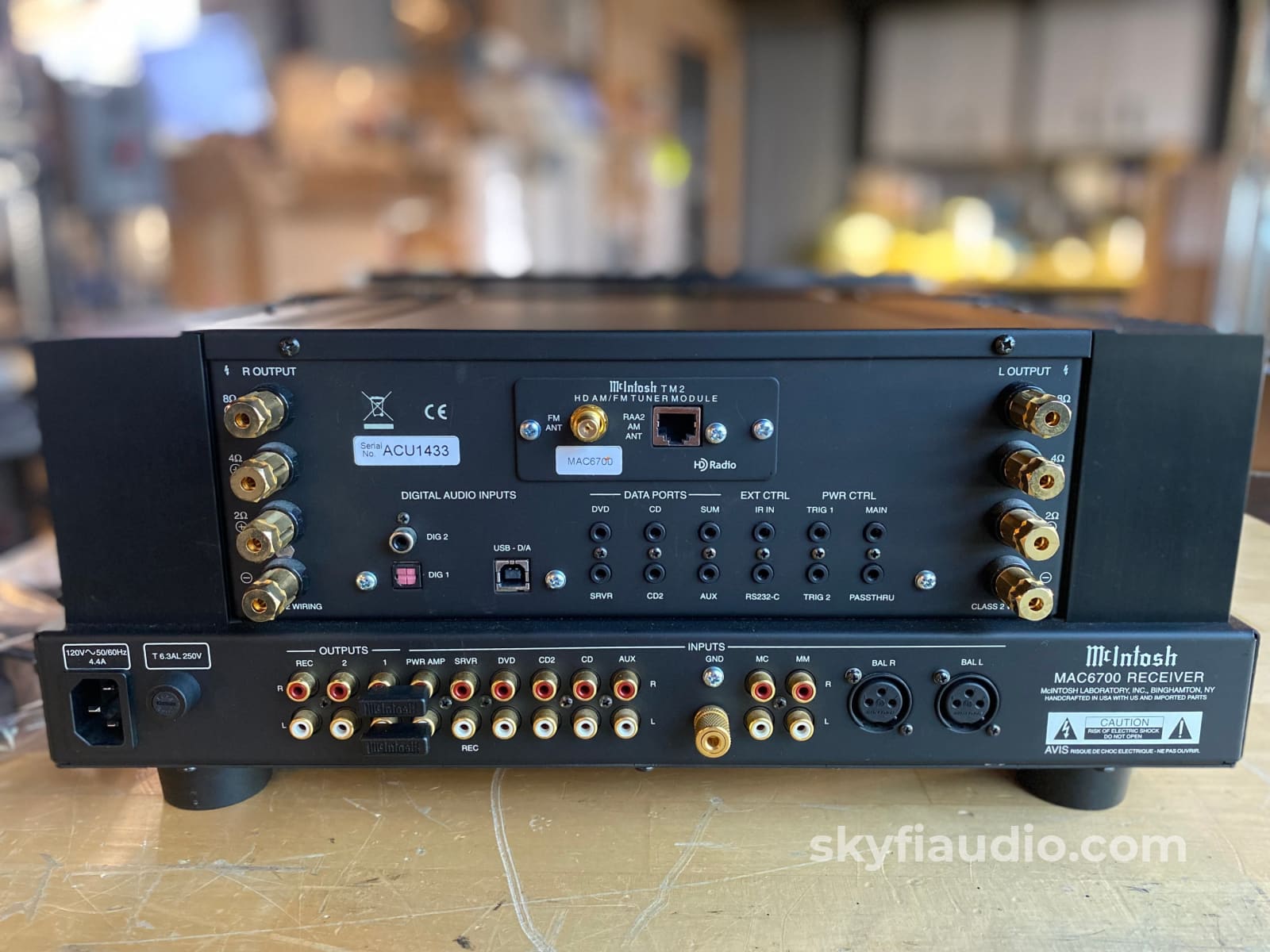
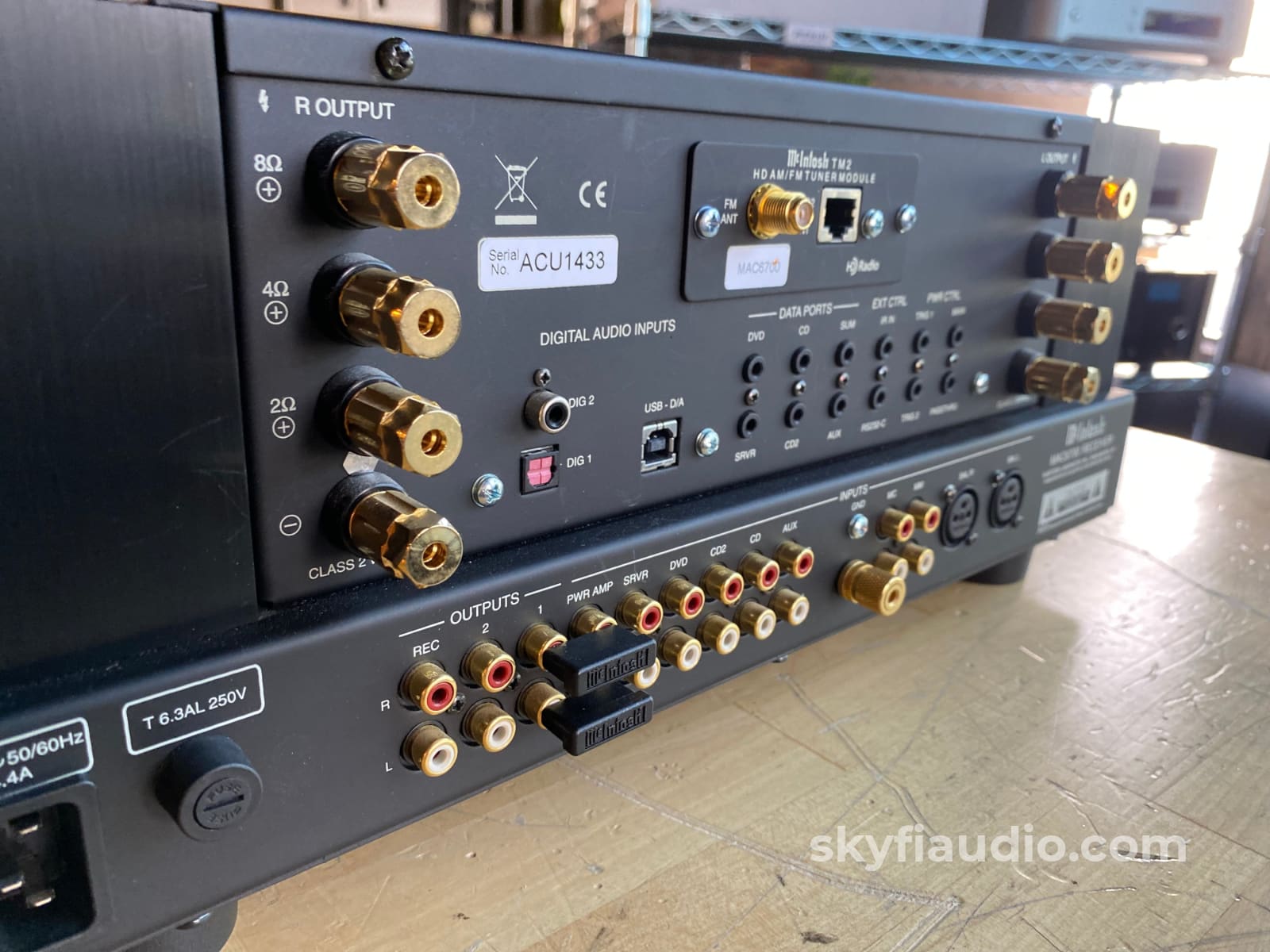
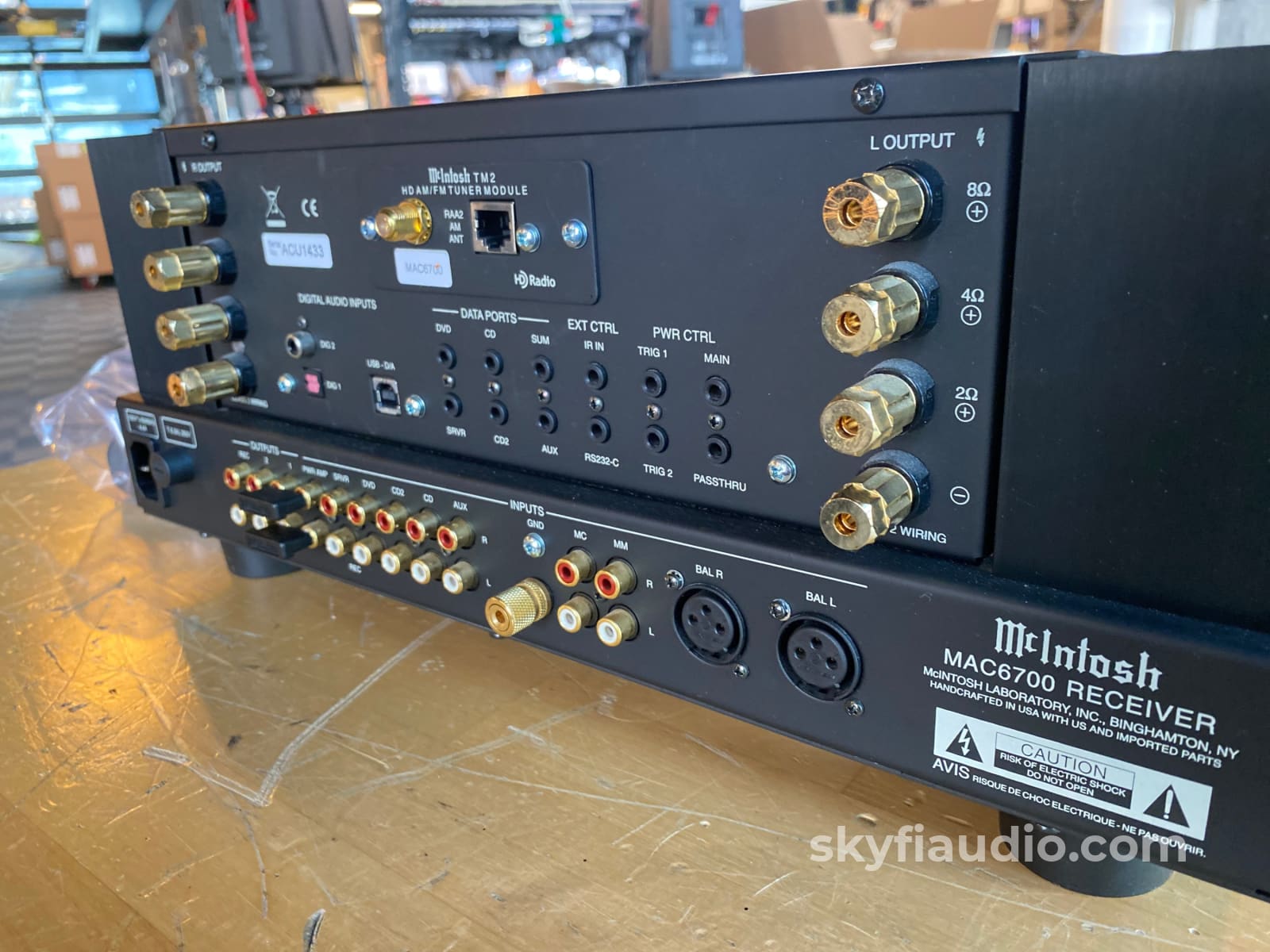


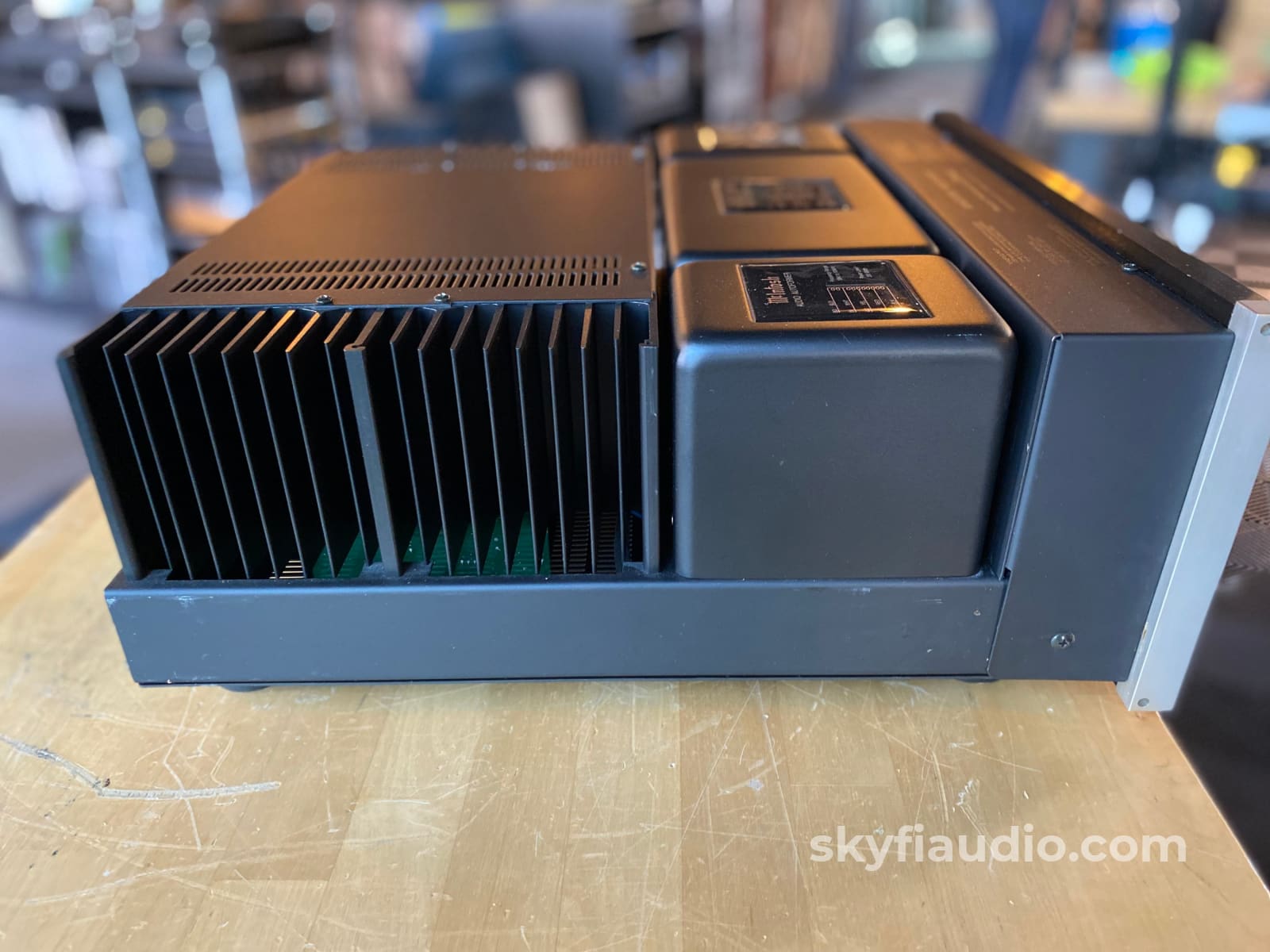
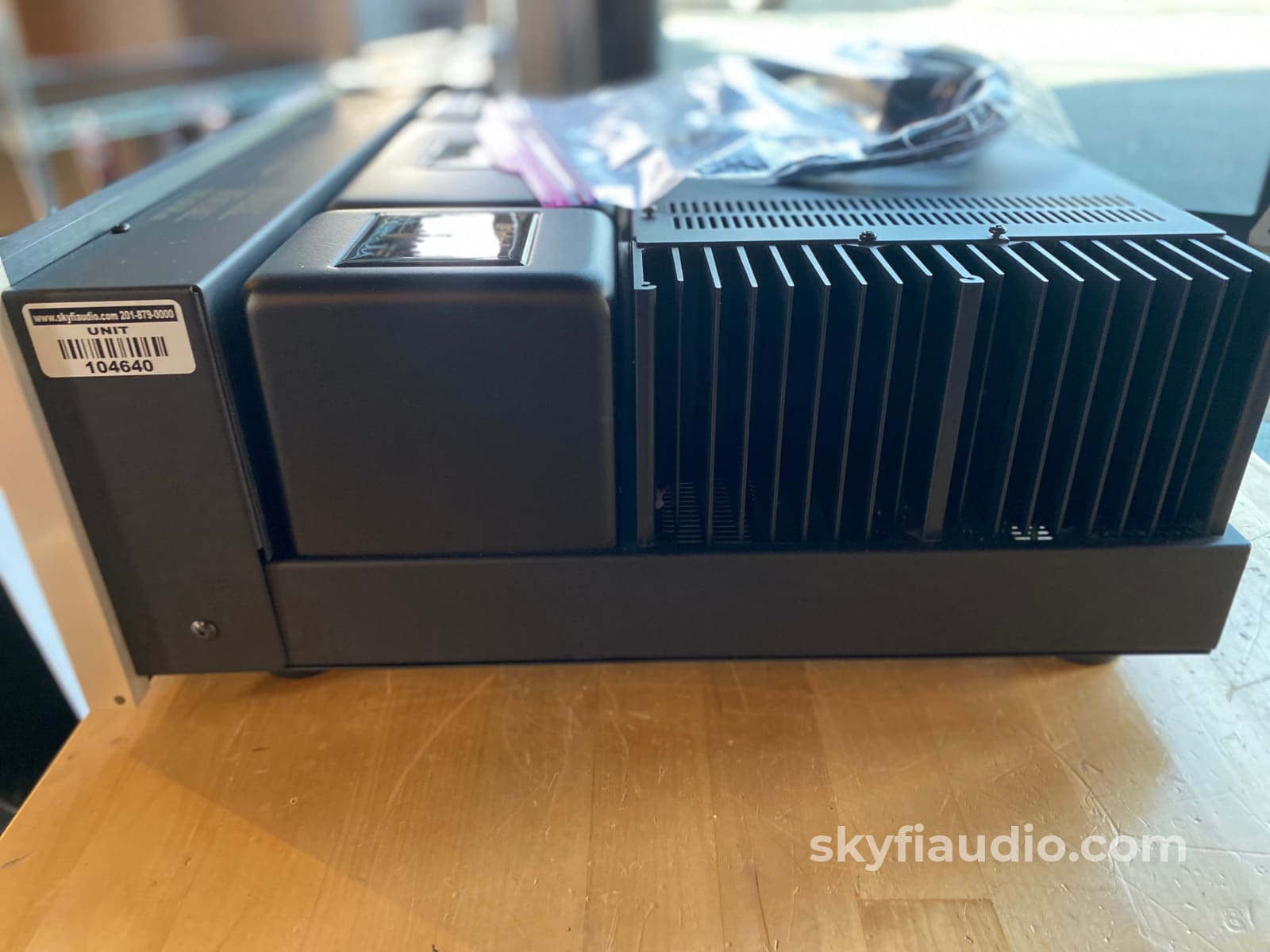
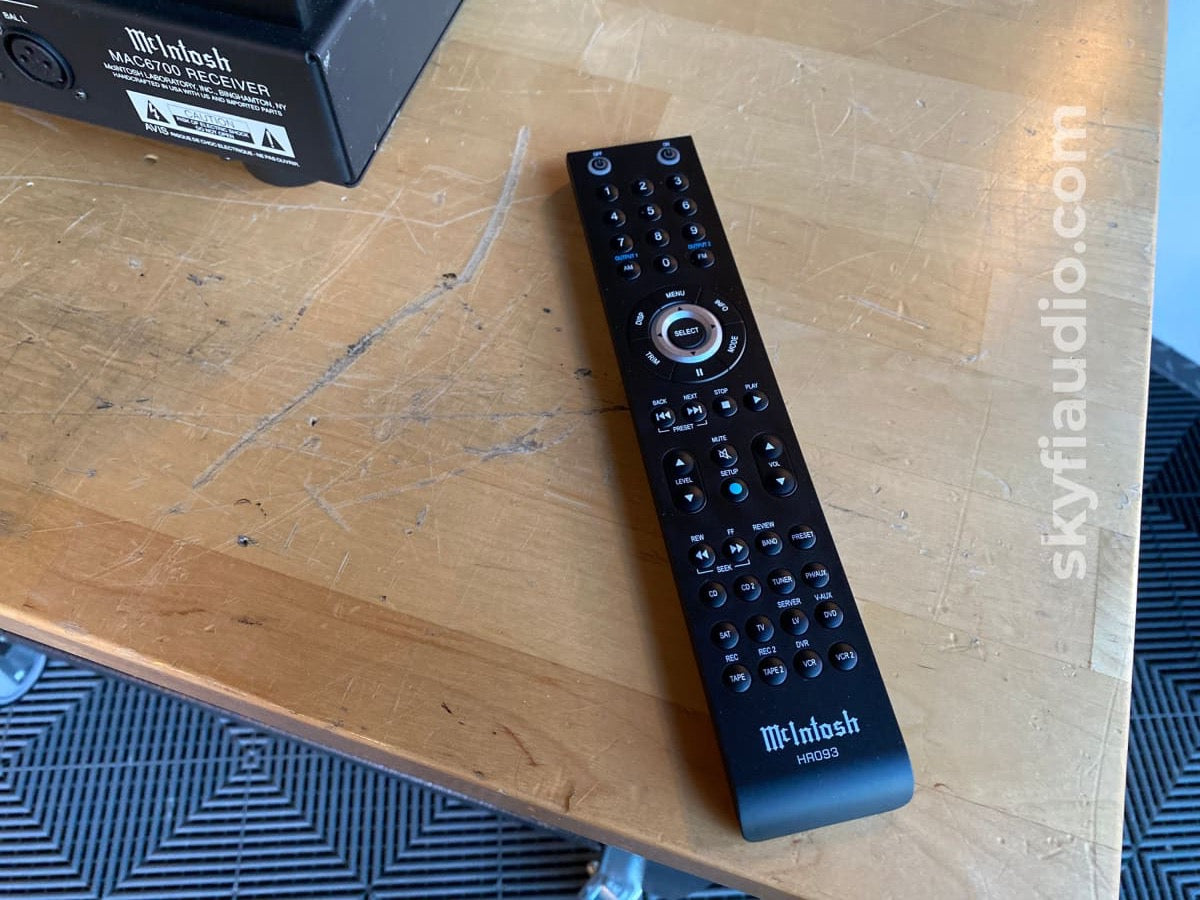
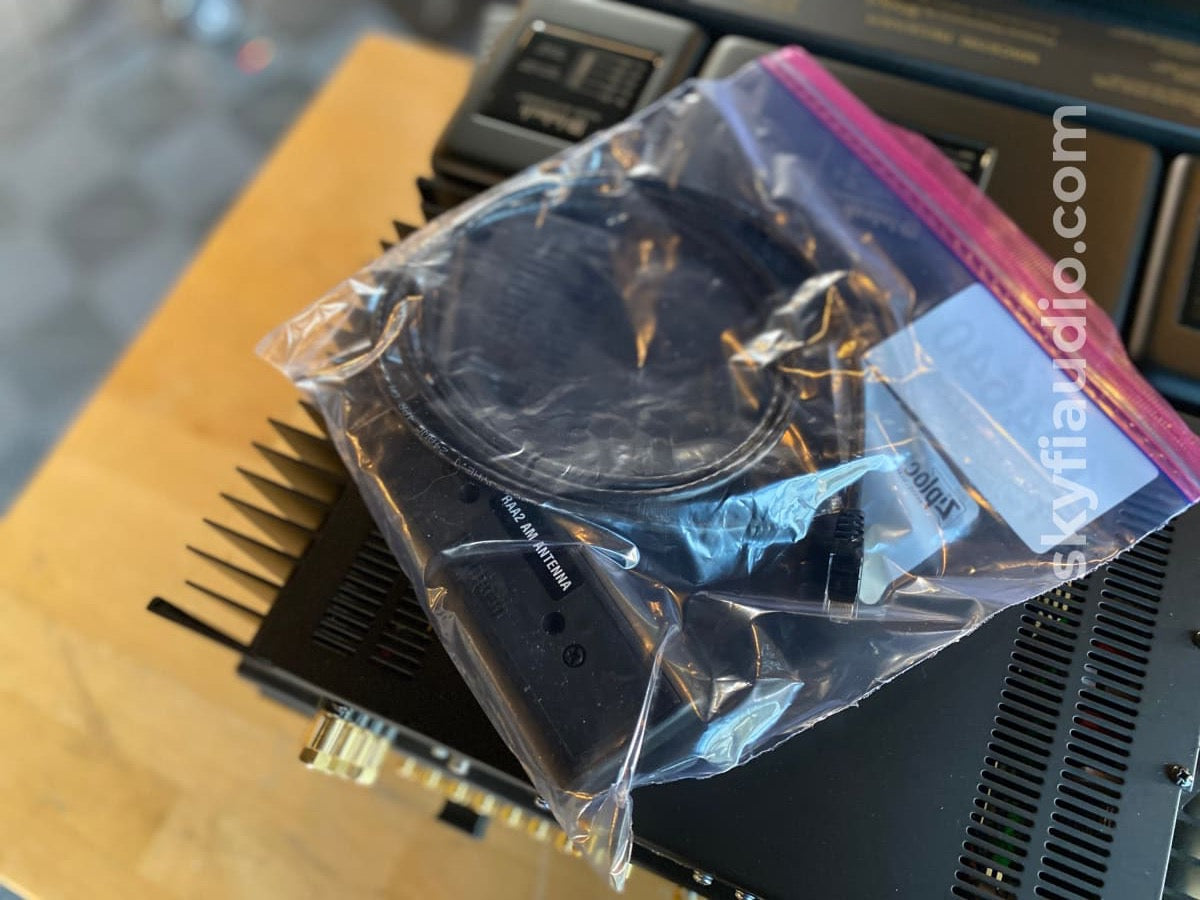
McIntosh MAC6700 Solid State Receiver with HD + FM/AM Radio, DAC, MC/MM Phono
Free Shipping on Most Electronics - Excludes Speakers and Items Requiring Freight - Contiguous U.S. Only
Pickup currently unavailable at SkyFi 479

McIntosh MAC6700 Solid State Receiver with HD + FM/AM Radio, DAC, MC/MM Phono
SkyFi 479
479 South Broad Street
Glen Rock NJ 07452
United States
General:
Fantastic piece from McIntosh and a recent revival, as McIntosh took some time off from making full featured receivers.
This one has it all.
200W per side with autoformers, gorgeous blue meters. built-in HD Radio and FM/AM tuner, outstanding headphone amp, built in DAC, and a capable MC and MM phono section.
If you're looking for a one piece solution for a 2 channel system this might be perfect for you.
We also worked with McIntosh to update the main system firmware to the latest version available, along with the official McIntosh USB Audio Firmware (DAC section firmware).
Includes a brand new modern remote from McIntosh, McIntosh RAA2 AM Antenna with connecting cord, and power cord.
McIntosh Performance Features Include:
• Power Output with Patented Autoformer
The MAC6700 consists of a 200 watts per channel stereo Power Amplifier with less than 0.005% distortion. The McIntosh designed and manufactured Autoformer allows connection of 2, 4 or 8 ohm Loudspeakers. The Power Amplifier uses ThermalTrak Output Transistors for lower distortion and cool operation.
• Digital Audio Inputs
The MAC6700 has Coaxial, Optical and USB Digital Inputs to Decode PCM Signals from an external source. The MA/MAC6700 Up Samples the Digital Signal to 192kHz with 32Bit resolution before the Digital to Analog process begins.
• Moving Coil and Moving Magnet Phono Inputs
The MAC6700 contains two different precision Phono Preamplifier Circuits. One for low output Moving Coil Phono Cartridges with selectable resistance loading, the other is for Moving Magnet Cartridges. Both circuits use the latest designs to provide the lowest possible noise and distortion. The RIAA Correction Equalization Circuitry utilizes close tolerance resistors and capacitors for an extremely flat frequency response.
TM2 Tuner Module Performance Features • Reception
The TM2 Tuner Module with HD Radio Technology allows for the reception of high quality FM and AM Radio Broadcasts in regions where available.
• Digital Sound
Digital, CD-quality sound. HD Radio Technology enables local radio stations to broadcast a clean digital signal. AM sounds like today’s FM and FM sounds like a CD.
Technical Notes:
A new McIntosh HR093 remote will be provided with this unit
Brand Background:
McIntosh Laboratory is an American manufacturer of handcrafted high-end audio equipment based in Binghamton, New York. The company was founded in 1949 by Frank McIntosh. The company designs and produces audio amplifiers, stereo tuners and other consumer electronics products.
Ownership:
Single Owner
General Sound:
Smooth, uncolored, undistorted natural and clean
Cosmetic Condition:
7/10 = Good. One or two minor scratches. Well Maintained.. See our detailed rating description here.
Working Condition:
Working perfectly and tested in our lab and listening room.
Included:
Brand new modern remote from McIntosh, McIntosh RAA2 AM Antenna with connecting cord, power cord.
Packing:
Original Manufacturers Packing
Reviews:
Click Here
Specs:
Amplifier Specifications
Power Output
200 watts is the minimum sine wave continuous aver- age power output per channel, both channels operating
Output Load Impedance
2, 4, or 8 ohms
Rated Power Band
20Hz to 20,000Hz
Total Harmonic Distortion
0.005% maximum with both channels operating from 250 milliwatts to rated power, 20Hz to 20,000Hz
Dynamic Headroom
2.0dB
Frequency Response
+0, -0.5dB from 20Hz to 20,000Hz
+0, -3dB from 10Hz to 100,000Hz
Preamplifier Output 1 and 2 (for rated input)
1.4V unbalanced (8V Maximun)
Sensitivity (for rated output)
High Level, 250mV unbalanced, 500mV balanced
Phono MM, 2.5mV
Phono MC, 0.25mV
Power Amp In, 1.4V
Signal To Noise Ratio (A-Weighted)
High Level, 95dB below rated output
Phono MM, 84dB below 5mV input
Phono MC, 82dB below 0.5mV input
Power Amplifier, 113dB below rated output
Intermodulation Distortion
0.005% maximum, if the instantaneous peak power is 400 watts or less per channel with both channels oper- ating for any combination of frequencies from 20Hz to 20,000Hz
Wide Band Damping Factor
Greater than 40
Input Impedance
High Level, 20K ohms
Phono MM, 47K ohms; 50pF
Phono MC, 50, 100, 200, 400 or 1,000 ohms; 100pF
Power Amp In, 10K ohms
Maximum Input Signal
High Level, 8V unbalanced, 16V balanced
Phono MM, 80mV
Phono MC, 8mV
Power Amplifier In, 16V
Preamplifier Output Impedance
220 ohms
Headphone Output Impedance
20 to 600 ohms
Power Guard
Less than 2% THD with up to 16dB overdrive at 1,000Hz
Voltage Gain
High Level to Rec Output: 0dB
High Level to Output 1 and 2: 15dB
Phono MM to Rec Output: 40dB
Phono MC to Rec Output: 60dB
Phono MM to Output 1 and 2: 55dB
Phono MC to Output 1 and 2: 75dB
Power Amplifier: 29dB
Tone Controls
Bass Control ±12dB (1dB steps) @ 30Hz
Treble Control ±12dB (1dB steps) @ 10,000Hz
Digital Input Sample Rates
Optical: 16Bit, 24Bit - 32kHz to 96kHz
Coaxial: 16Bit, 24Bit - 32kHz to 96kHz
USB: 16Bit, 24Bit, 32Bit - 32kHz to 192kHz
Power Control and Trigger Output
12VDC, 25mA
TM2 - FM HD Radio Specifications
Sensitivity
-85dBm
Signal To Noise Ratio
85dB
Frequency Response
± 1dB from 20 to 20,000Hz
Harmonic Distortion
0.1%
Stereo Separation
80dB
TM2 - FM Analog Specifications
FM Tuning Range
87.5MHz - 107.9MHz
FM Channel Spacing
200kHz
Useable Sensitivity
1.6uV (15.2dBf)
50dB Quieting Sensitivity
1.8uV (16.2dBf)
Signal To Noise Ratio
Mono: 75dB Stereo: 72dB
Frequency Response
± 1dB from 20 to 13,000Hz
Harmonic Distortion
Mono: 0.1%
TM2 - FM Analog Specifications, con’t
Stereo: 0.4%
Channel Selectivity
65dB Adjacent Channel 74dB Alternate Channel
Stereo Separation
35dB
TM2 - AM HD Radio Specifications
Signal To Noise Ratio
85dB
Frequency Response
20 to 15,000Hz
Harmonic Distortion
0.1%
Stereo Separation
75dB
TM2 - AM Analog Specifications
AM Tuning Range
530kHz - 1710kHz
AM Channel Spacing
10kHz
Sensitivity
550uV/m
Signal To Noise Ratio
45dB
Frequency Response
+ 0, - 6dB from 100 to 3,500Hz
Harmonic Distortion
0.25%, 80% Modulation
Selectivity
50dB Adjacent Channel
TM2 - General Specifications
FM Antenna Input
75 ohms, Type “F” Coax connector
AM Antenna Input
Balanced, RJ45 connector
(for use only with supplied McIntosh RAA2 Remote AM Antenna)
RAA2 Connection Cable
20 foot (6.09m) 8 conductor straight-thru cable with an outer shield and RJ45 connectors on each end (shielded CAT5 or CAT6 patch cable)
RAA2 Remote AM Antenna Overall Dimensions
Width is 6 inches (15.24cm)
Height is 2-1/2 inches (6.35cm)
Depth is 1-1/2 inches (3.81cm)
General Specifications
Power Requirements
Field AC Voltage conversion of the MA/MAC6700 is not possible. The MA/MAC6700 is factory configured the following AC Voltages:
120 Volts, 50/60Hz at 4.4 amps
Standby: Less than 0.25 watt
Dimensions:
Width is 17-1/2 inches (44.45cm)
Height is 7-5/8 inches (19.37cm) including feet Depth is 22 inches (55.88cm) including the Front Panel, Knobs and Cables
Approximate Age:
2015
Link to Manual:
Click Here
Recommended Cables:
Kimber Kable - RCA Interconnects - Better
Kimber Kable - RCA Interconnects - Best
Kimber Kable - BALANCED XLR Connectors - Better
Kimber Kable - BALANCED XLR Connectors - Best
Kimber Kable - Select Series Reference USB Cable
Kimber Kable - Coaxial Digital Interconnect
Kimber Kable - Optical Digital Interconnect
Kimber Kable - Speaker Cables - Better
Kimber Summit Series Monocle XL Speaker Cables (PAIR) - Best
Kimber Summit Series BiFocal XL Bi-Wire Speaker Cables (PAIR) - Best If Applicable
Kimber Kable - Power Cords - Better
Kimber Kable - Power Cords - Best
The SkyFi Testing Process for Integrated Amplifiers:
We start with a visual inspection of all internal components to make sure that there are no signs of heat stress or damage. Capacitors are checked for telltale signs of predictive failure including bulging, shrunken wrappers, or physical leakage. We also inspect the PCBs for discoloration from resistors or transistors that may have been running hot. On vintage units we often spot check select capacitors for value and ESR.
If the device has the ability to decouple the preamplifier from the power amplifier, we remove the jumpers and independently test each section. If the device cannot be decoupled, we assess the electronic condition of the piece by analyzing the speaker level output only.
We start by connecting the “preout” jacks of the integrated to a Sencore PA81 Power Analyzer which simulates real world loading conditions and gives us an oscilloscope interface. The first order of business is checking that the volume control works smoothly throughout its entire range with acceptable channel balance. This is accomplished by feeding a 1KHz sine wave into one of the preamp’s line level inputs while monitoring the preamp’s output on an oscilloscope. We then switch to a 1KHz square wave to test the tone controls, loudness function, and filters where applicable. During this step we are watching for equal alteration of the test signal by both channels. This also helps us identify dirty controls that will need treatment. Once the basic line stage functions are verified, we test each input individually. This is especially important for devices that use relays to select their sources. If the preamp section is equipped with a phono stage we test that as well. We use an inverse RIAA filter which allows us to feed a reference test signal into the phono input with the proper RIAA equalization and level. A square wave or sine sweep is used to verify that the device’s phono stage is faithfully reproducing the RIAA curve.
Next, we test the power amplifier section by connecting the integrated’s speaker outputs to a Sencore PA81 Power Analyzer which acts as a dummy load, DC offset monitor, and oscilloscope interface. We start with a low level 1KHz test signal at the “main in” jacks and slowly increase its amplitude while monitoring the output on an oscilloscope for signs of noise, clipping, distortion, or improper channel balance. We continue increasing the signal level until the amplifier reaches clipping. At this point we take an output power measurement and compare it to the spec sheet of the amplifier to verify proper performance.We finish off the bench evaluation with a 1KHz square wave check and a 20Hz to 20KHz sine sweep to assess the amplifier’s frequency response characteristics. This battery of tests will usually reveal if the amplifier has any issues that need further attention.
If the preamp and power amp both pass these tests, we reconnect the sections and verify that the preamp section can drive the power amp to rated power with a 1KHz tone on one of the line level inputs.
Before the device leaves the bench, we perform a listening test with actual music using a variety of preferred test tracks. Our benches are outfitted with familiar monitor speakers which help us identify inconsistencies that will not always show up on our test gear. The main things that we are listening for are hum or noise with no signal present, proper center image, clicks, pops, or any other obvious undesirable audio characteristics.
If the unit passes all of these tests it is moved to our long term testing rig where we simulate real word operating conditions for 6-8 hours. This allows us to monitor the unit for signs of thermal runaway or intermittent issues that only crop up when the unit has fully come up to temperature.
Choose options
